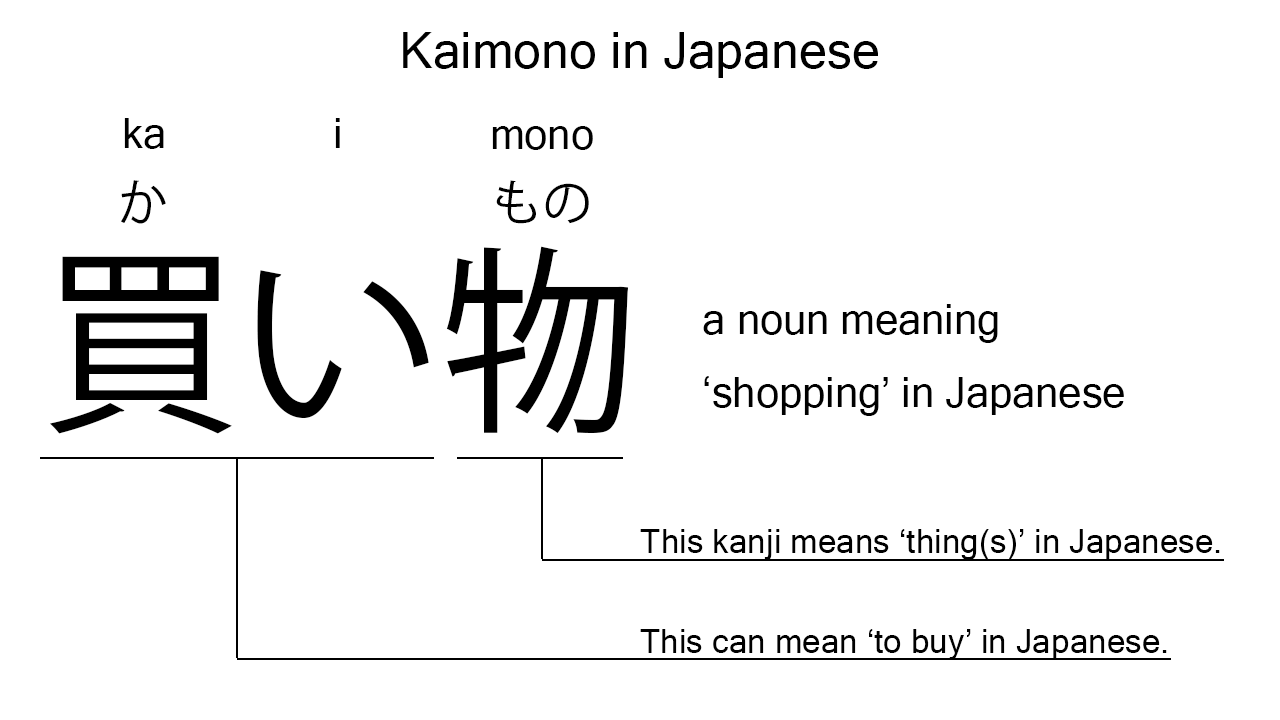What does “kaimono” mean in Japanese?
Native speakers say “kaimono” to mean ‘shopping’ in Japanese. Perhaps, some Japanese learners know this word as it is sometimes used in Japanese conversations. In this blog post, however, I will explain this word in detail based on its grammatical components. And also, I will explain how to use it through example sentences. My explanations would help Japanese learners understand “kaimono” more clearly. Then, let’s get started!
Contents
Definition and meaning of “kaimono”
Let me start with the definition and meaning of “kaimono”.
- kaimono – 買い物 (かいもの) : a noun meaning ‘shopping’ in Japanese.
Native speakers use this noun to refer to the act of buying or purchasing something in Japanese. So, its usage is very similar to that of the English noun, “shopping”, I think.
The definition and meaning are simple and clear. To understand this noun more clearly, however, let me explain its grammatical components in detail, one by one.
What does “kaimono” literally mean in Japanese?
“Kaimono” consists of the following two components:
- kai – 買い (かい) : one conjugation of the verb, “kau“, which means ‘to buy’ in Japanese.
- mono – 物 (もの) : a noun meaning ‘thing’, ‘stuff’, or such in Japanese. Depending on the words used together, this can also mean ‘something’ or ‘anything’.
From these two components, we can understand that “kaimono” literally means ‘things to buy’ in Japanese. This literal interpretation is not completely in line with the actual meaning, but still very close, I think. Usually, we go shopping for things to buy.

When we meet new Japanese words, we should check their grammatical components in detail to understand their meanings clearly and deeply. In many cases, components tell us a lot about the meanings of the words they form. Actually, here, we could get the better understanding of “kaimono” through the detailed check above.
So far, I’ve explained the definition and meaning of “kaimono” together with its grammatical components. Then, let me explain how to use it through the example sentences below.
Example #1: how to say “shopping” in Japanese
boku wa kaimono ga suki desu – 僕は買い物が好きです (ぼくはかいものがすきです)
I love shopping.
Below are the new words used in the example sentence.
- boku – 僕 (ぼく) : a pronoun meaning ‘I’ in Japanese. This is used mainly by boys and young males.
- wa – は : a binding particle working as a case marker or topic marker. In the example, this works after “boku” to make the subject in the sentence.
- ga – が : a case particle used to make the subject word or the object word in a sentence. In the example, this is used after “kaimono” to make the object in the sentence.
- suki – 好き (すき) : the stem part of the na-adjective, “sukina”, which means ‘favorite’ in Japanese. Native speakers, however, often use this as an individual word to mean ‘to like’ or ‘to love’ in Japanese. In the example, this is used to mean ‘to love’.
- desu – です : an auxiliary verb used after a noun or adjective to make it polite. Probably, this is well known as a part of Japanese desu form. In the example, this is used after “suki” to make it sound polite.
This is a typical usage of “kaimono”. In this example, it works together with the case particle, “ga”, to become the object in the sentence.
Example #2: another usage of “kaimono”
watashi tachi wa mise de kaimono wo shi ta – 私達は店で買い物をした (わたしたちはみせでかいものをした)
We did shopping at the shop.
Below are the new words used in the example sentence.
- watashi – 私 (わたし) : a pronoun meaning ‘I’ in Japanese.
- tachi – 達 (たち) : a suffix used after a noun or pronoun to make its plural form. In the example, this is used after “watashi” to make its plural form, “watashi tachi”, which means ‘we’ in Japanese. Learn more about Japanese plural.
- mise – 店 (みせ) : a noun meaning ‘shop’ in Japanese. This can also work as plural.
- de – で : a case particle used to say where someone does something. In the example, this is used after “mise” to say where the speakers did shopping.
- wo – を : a case particle used to make the object word in a sentence. In the example, this is used after “kaimono” to make the object in the sentence.
- shi – し : one conjugation of the verb, “suru“, which means ‘to do’ or ‘to perform’ in Japanese. In the example, it has been conjugated for the better connection with its following word.
- ta – た : an auxiliary verb used after a verb, adjective, or auxiliary verb to make its past tense form. Probably, this is well known as a part of Japanese ta form. In the example, this is used after “shi” to make its past tense form, “shi ta”.
This is another typical usage of “kaimono”. In this example, it works as a part of the commonly-used phrase, “kaimono wo shi ta”, which means ‘did shopping’ in Japanese. When we want to mean ‘shopping’ in Japanese, anyway, this noun is always a very good option.
Summary
In this blog post, I’ve explained the definition and meaning of “kaimono” in detail based on its grammatical components. And also, I’ve explained how to use it through the example sentences. Let me summarize them as follows.
- kaimono – 買い物 (かいもの) : a noun meaning ‘shopping’ in Japanese. Japanese native speakers use this noun to refer to the act of buying or purchasing something. So, the usage is very similar to that of the English noun, “shopping”. This noun literally means ‘things to buy’ in Japanese. This literal interpretation is not completely in line with the actual meaning, but still very close, I think. Usually, we go shopping for things to buy.
Hope my explanations are understandable and helpful for Japanese learners.